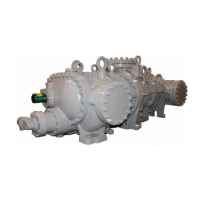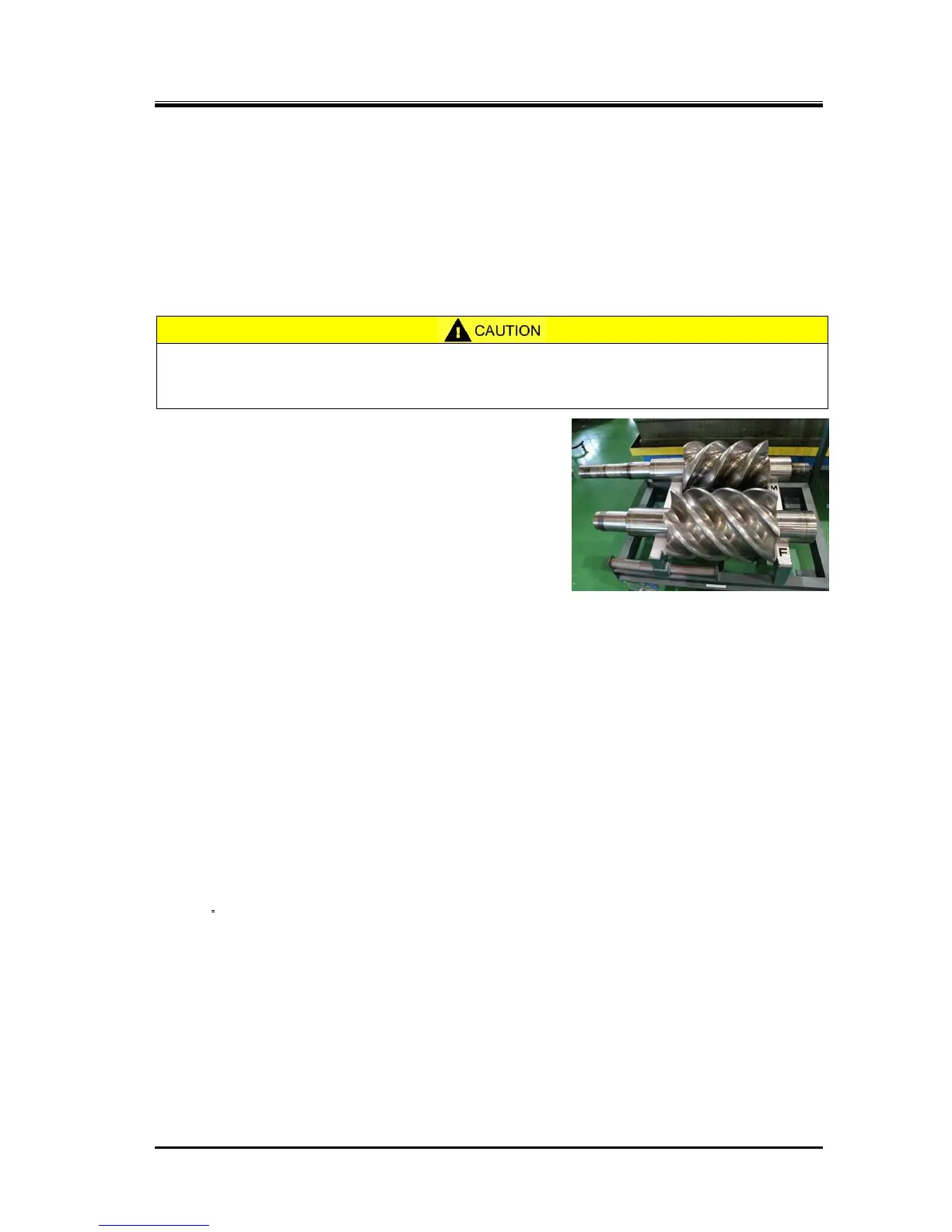2201Q4JE-MY-C9-N_2018.01.
Chapter 5 Maintenance and Inspection
Compound 2-stage Screw Compressor 4032**C 5.4 Disassembly and Inspection
5-30
5.4.12 Rotors and Main rotor casing (Low-stage/High-stage)
5.4.12.1 Disassembly
a) While you can pull out the rotor either from the M or F side, you should be very careful in the work
as both of rotors are very heavy. In particular, be careful not to flaw the Low-stage M rotor shaft
because the shaft area is installed the mechanical seal assembly. We recommend you to protect
the shaft portion using curing tapes beforehand.
When pulling out the M rotor (or F rotor) first, pull out about 2/3 of the full length of the rotor by
holding the shaft upward a little and turning it in the CW (or CCW) direction.
b) As a preparation, use a nylon belt or other lifting belt that
will not blemish the lifting surface to support the center of
the rotor. Then, pull out the rotor while slightly lifting up
the rotor using the belt.
c) The pulled out rotor should not be directly placed on the
floor. Use appropriate wood boards to support the rotor as
a cushion to prevent blemishing or use V-blocks to
support the shaft to prevent blemishing of the outer
surface (See right picture.)
5.4.12.2 Inspection
a) No abnormality should be observed on the surface of the rotor lobes under normal operations.
Regarding the contact surface of the lobes black luster should be seen on the root area of the M
rotor lobes and on the tip area of the F rotor lobes.
In other cases, when the suction gas or oil is contaminated by fine dust, there may be fine linear
scratches on the shaft surface, in the direction perpendicular to the shaft axis. If any such flaw is
found, use a fine sandpaper or grindstone to smooth the surface.
b) In case of ammonia refrigerant or gas compressor, the non-contact surface of the rotor may be
discolored by rust or deposits. Use sandpapers or others to finish the surface according to the
degree of the problem.
c) Then, check the bearing areas of the rotor shaft. Two types of finishing are used: one is the
induction hardening (polish finishing) for the standard specification, and the other is the hard
chrome plating (polish finishing), as a special specification. The most suitable finish is selected
according to the type of refrigerant and operation conditions.
Very little wear will be present unless the compressor is operated for a long time using dirty oil or
any hard matter is buried in the metal of the inner circumference of the bearing.
d) Check the portion of the shaft on which the thrust bearing is mounted for any trace to show that the
inner race of the bearing has rotated. f the lock nut that fastens the inner race of the thrust bearing is
loosened, or if the bearing is abnormally worn, the inner race will become rotate. If any trace of
rotation is seen, correct the problem. Depending on the degree of the rotating trace, it might be
necessary to replace the rotors with new ones.
e) Check the inner surface of the main rotor casing.
There is a narrow clearance between the periphery of the rotor and the main rotor casing. Any slight
flaw present on the tip of the rotor lobes or on the inner surface of the main rotor casing, due to
small foreign matters, will not be a problem.
If there is any trace to show that the tips of the rotor lobes have hit the inner surface of the main
rotor casing, it is an abnormal condition. In such a case, the possible cause is that the main bearing
and/or side bearing is worn out. Take proper actions by finding the cause of the problem, such as
contamination of the lubricating oil or entrance of foreign matters.

